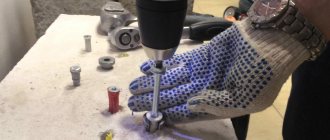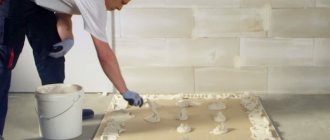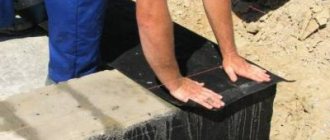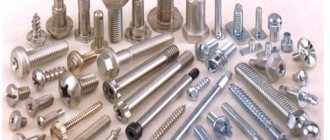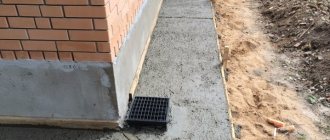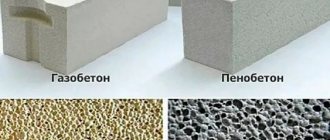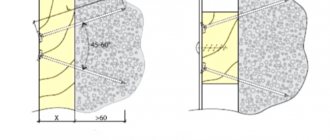In the building materials market, fasteners are presented in a very wide range to solve various problems. Let's look at how to choose the right dowel for a foam block. Let's get acquainted with the features and relevance of using specific samples made of plastic or metal, as well as chemical anchors. Read to the end, and you will learn about the rules and recommendations from installation specialists.
Nylon dowel for porous base Source werkman.ru
Characteristics
When choosing a dowel for a foam block, we pay attention to the following characteristics of this fastener.
- Length. This is especially important when installing on thin heat-insulating foam blocks, so that the dowel does not end up being longer than the width of the foam concrete block. Well, in other cases we select it according to the length of the fastening element.
- Diameter. In a bundle, the diameter of the fastener is important. We carefully select the drill so as not to drill a hole of a larger diameter!
- The size of the spacer. The strength of fixation of the entire structure largely depends on it.
- Permissible load that the dowel can withstand. No comments here, better with reserve.
- Resistance to moisture when installing external structures. The last item on the list, but don’t forget about it when doing exterior work. Important.
Only with a suitable choice can you guarantee the reliability of fastening, which has a direct impact on the durability of structures, the safety of operation of cabinets and shelves mounted on walls, air conditioners and boilers.
Chemical anchor
This type of fastening, such as a chemical anchor, is a fairly new and already in demand method. The builders appreciated it. Chemical anchoring has its advantages and disadvantages. The advantages of a chemical anchor include:
- high load capacity factor on fasteners;
- compliance with GOST, the chemical composition is safe and environmentally friendly;
- versatility, it is used for any building material;
- high resistance to weather fluctuations and low temperatures;
- low price when compared with steel anchors.
The disadvantages include:
- strict adherence to technology;
- purchase of special equipment, namely brushes, pumps, guns and drills;
- additional time for the chemical solution to harden.
Chemical fasteners for foam concrete include a threaded steel pin, maybe a special rod, a chemical mixture, and additional bushings.
Chemical anchor fastening sequence
- Use a drill to make a cylindrical hole. Then it needs to be shaped into a cone with an expansion in depth.
- The finished hole is thoroughly cleaned. You can use a pump for this.
- A centering sleeve is inserted into the base.
- A chemical solution is poured into the hole through the sleeve; a construction gun is used for this.
- The threaded rod (stud) is screwed in.
- Leave time until the chemical solution hardens completely.
The chemical anchor kit includes an easy-to-use package with a dispenser. Installation is easy, while achieving high structural strength.
Fastening chemical anchors
And so, for fastening light structures and decorative elements, ordinary self-tapping screws are quite suitable. They can be designed for working on wood or on cellular concrete. Nails for aerated concrete should have a wedge shape or a curved tip inside the concrete cavity.
For heavy structures, such as plumbing fixtures, kitchen cabinets, boilers, it is worth using foam concrete fasteners with wedging dowels. Reliable fixation is achieved precisely thanks to the internal stop. All hardware must be resistant to corrosion. This especially applies to mountings on an external wall.
Types of fasteners
Regardless of what the foam block dowel is made of, they all work on the same principle. A screw-in self-tapping screw pushes the walls of the cage apart and wedges them into the hole. Due to the increased friction force, arbitrary removal of fasteners from foam concrete blocks under the weight of the fixed structure is impossible without additional effort.
Based on the installation principle, a dowel for a foam block, like any other, can be divided into two popular categories.
- Hammerable, designed for installation of light structures and parts.
- Screw-in, which can withstand heavy loads.
There is, however, one more category that is used less frequently. This is a chemical dowel for a foam block, with the fastening element installed using epoxy or other polymer glue. Yes, it is reliable, but much more expensive. Therefore, it is used selectively. This option is often used when installing powerful studs or screws designed to hold heavy structures. Then this applies more to anchors.
If we use a chemical dowel for a foam block, we take special care when working on finishing. This is due to the fact that during installation, part of the injection solution can often be squeezed out. And the coloring pigment contained in it can damage finishing materials.
Perhaps I recommend watching the following video here. Although it uses a gas block, all this also applies to a foam concrete block. In addition to generally good tests, towards the end an excellent alternative to the classic chemical dowel is shown.
For external work we use rust-resistant fasteners - metal, galvanized or anodized, as well as from various types of polymers.
To work with soft thermal insulating foam blocks, it is recommended to use screw-in types of dowels. They are designed to be installed with self-tapping screws or threaded screws. Installation is carried out with a drill or a powerful screwdriver. Due to the low density of the material, no difficulties arise during installation.
Below you can find out what a dowel for a foam block can be like.
Metal
It is a steel or brass hollow sleeve with longitudinal cuts. It can be either driven in or screwed in. Supplied complete with fasteners, but even with the same diameter it can be used for different types of self-tapping screws.
Therefore, please note that if dowels separately are much cheaper, you can buy them and assemble the kits yourself without overpaying for ready-made ones.
While metal dowels with a smooth outer surface are suitable for standard concrete, this option is not suitable for foam concrete blocks. The force generated during opening may not be sufficient to secure it in porous foam concrete. For foam blocks we use metal dowels only with a corrugated outer surface. In addition, you can bend 2-3 tabs on the outer rim; when installed, they will fit into the wall and prevent scrolling.
Basically, metal dowels for foam blocks are used for fastening elements of suspended load-bearing facade systems, internal cladding frames, furniture cabinets and other heavy objects. Products with a diameter of 10-12 mm are comparable in load-bearing capacity to metal anchors.
Plastic
It is the plastic dowel for foam blocks that is most often used. It also happens to be driven in or screwed in, which is less common, with an external thread. Diameter from 4-5 to 15-25 mm. Depending on their size, they are used for fastening both light and heavy objects and hanging structures.
In addition to standard ones, secret options are possible. They differ from each other by the presence of a “fungus” (supporting platform) in the upper part.
Interestingly, depending on the scope of application, they have different lengths of the split part (the larger this parameter, the more reliable the fastener).
For more reliable fixation, dowels with additional external tendrils are used to prevent spontaneous removal.
When choosing plastic products, you should take into account the fact that certain types of materials become brittle at low temperatures. As a result, they may break when twisted or hammered. Therefore, for outdoor work or installation in unheated rooms in winter, it is better to choose fasteners made from other materials, such as nylon.
Nylon
In appearance, it does not differ from plastic elements, is produced in the same standard sizes, and is used for fastening battens, light and medium-weight structures. Advantages: increased tensile strength, possibility of use at temperatures up to 40 degrees below zero.
Among other advantages of nylon dowels for foam blocks, we note:
- resistance to deformation when driving;
- reliable fixation under dynamic loads;
- inability to remove from the wall even with great effort;
- resistance to aggressive substances and corrosion.
Nylon dowels for foam blocks are used when installing critical structures. In terms of price, it is slightly more expensive than simple plastic ones, so this choice is quite advisable.
Dowel nail
The standard dowel nail is designed for through fastening of various materials to wall structures. It is distinguished by an increased diameter, which increases strength and resistance to deformation when driving. Installation using such nails is carried out manually or using pneumatic or electric guns (hammers).
For cellular concrete, due to its low strength, the use of standard fasteners of this class is almost impossible: they are simply pulled out of the wall. Therefore, for foam blocks we use a special dowel-nail of a composite structure, with an outer drop-down collar.
The installation principle is as follows:
- hammer into the wall in the standard way by hitting the head;
- To fix it in the wall, we finish off the central fastening rod to expand the outer frame.
Only in this case will the load-bearing capacity of the dowel nail be ensured.
Separately, it should be noted that the use of such fasteners in heat-insulating foam blocks of the D200-D300 brands is absolutely impractical. They do not guarantee long-term durability of the fixation.
Frame
Used for installing aluminum and plastic window and door blocks. Each element can withstand a load of 30-50 kg. No more is required to solve the problem, since the main fixation is provided by polyurethane foam.
The frame dowel for the foam block, of course, in its design is more related to anchors; it consists of a movable screwed part and a split outer sleeve.
Differences of this type of elements:
- when the screw is tightened, the upper and lower parts of the sleeve expand, which increases the reliability of fixation;
- the expansion of the petals is ensured by movement along the thread of the conical bushing;
- The fastener has a countersunk head for a Phillips screwdriver or screwdriver bit.
For the installation of heavy structures, more powerful frame fasteners with a bolt head are used.
Practice has shown that it is almost impossible to remove the frame dowel for the foam block after installation, so they should be installed with the utmost care and precision, otherwise the holes will have to be redrilled.
For thermal insulation
To install polystyrene foam or basalt wool during the installation of suspended ventilated facades and insulation, special umbrella dowels (fungi) are used. They are distinguished by an increased area of the upper support platform, which allows you to reliably press the heat-insulating material. An additional advantage of such fasteners is the absence of cold bridges, which prevents freezing of the insulation and the wall.
For foam blocks, such a dowel comes with an enlarged spacer part, which is due to the insufficient strength and density of the wall material. The total length should exceed the thickness of the insulation by 1.5-1.7 times: only in this case can reliable fixation be guaranteed.
For foam plastic, dowels with a plastic central rod are suitable; for heavy mineral wool, fasteners with a galvanized steel nail are used. If there is a risk of corrosion, the umbrella is closed with a stopper, which prevents moisture from penetrating the metal.
Advice and experts and conclusion
Experts in the construction industry are inclined to believe that it is not worth attaching heavy and large structures to foam blocks. If you can choose a more durable base, it is better to choose it. If working with foam blocks cannot be avoided, and you intend to install complex structures, then it is better to opt for chemical anchors.
When working with hardware, it is not recommended to use electric tools. For many it will be a discovery that ordinary screws can be used in porous foam blocks. This is only permissible when installing objects of small weight.
You need to choose a dowel for a specific type of work. Before purchasing fasteners, make sure they can perform their function. Fasteners for foam blocks are not too expensive, as is the material itself.
Famous manufacturers
The cost largely depends on the popularity of the manufacturer and its advertising costs. At the same time, in terms of strength indicators and load-bearing capacity, the products of Russian and foreign companies do not differ.
Among domestic manufacturers we highlight:
- , offering a large selection of fasteners and tools for construction work;
- RosDubel enterprise, specializing in dowels, anchors, and other types of elements for connecting various materials and structures.
Good options are offered by Polish companies, for example Koelner, Rawlplug, which produces plastic products, Modeco, which produces metal elements. The products of the Swiss brand Mungo also deserve attention. Manufacturers from France (SNR) and Finland (Sormat) are not far behind them.
When purchasing, pay attention to the amount of fasteners in the package. By purchasing such a product individually, you risk overpaying 1.5-2 times. Choose sets of 200-500 pieces: it will be cheaper.
Briefly about use
Installation rules depend on the type of dowels used. The main role is played by the installation method:
- The driven type is installed in pre-drilled holes, the diameter of which must exactly match the dimensions of the element. If there is an error of 1-3 mm, it will not be possible to fix the part in the wall with the required degree of reliability.
- Screw-in fasteners can be used without drilling holes in low-density insulating foam blocks. Metal dowels can be screwed into structural foam concrete of grades D400-D800 without any problems.
It is better to hammer the dowel into the foam block with a rubber hammer. Thus, we reduce the risk of damage to the foam concrete block.
Among the general recommendations we note:
- before installation, it is necessary to carry out markings in accordance with the features of the structure being fixed;
- After drilling, you should clean the holes with a brush or pneumatic tool, thereby increasing the reliability of installation.
In general, installing a dowel in a foam block is not difficult; even a beginner can handle this installation.
Wooden dowels for foam block walls
Wooden blocks, and sometimes even matches, may be needed to secure small objects in a foam block wall. This is a simple and cheap, but not very reliable method of fastening. But it is worth considering, since in everyday life such a dowel will always be at hand.
Wooden dowels are most often used not for fastening, but for solving problems with old holes. If the hole does not fit a particular hardware, is deformed, or you need to seal it completely, wooden elements may come in handy. You can buy a wooden dowel from a store or make one yourself. For a homemade dowel, you will need a wooden chop of a suitable diameter to fit the existing hole, and then drive it in. For the strongest possible connection, the chop must be larger in diameter than the hole. When driven in, it will be possible to ensure a strong adhesion. After this, you can install the nail or screw. This is a type of simple fastening that will help you in solving everyday problems.
Which is better
It is impossible to say unequivocally which is better. Because when choosing, you need to take into account the type of structures and the specifics of the tasks being solved. In general, we use frame dowels for windows and doors; plastic and nylon are suitable for lightweight structures; for heavy load-bearing facade systems we choose metal options.
Pay attention to the correspondence of the length of the dowel to the thickness of the walls and the materials being connected. If the size of the expanding part is not enough, then there can be no talk of any reliability of fastening. And one more thing to remember: always buy dowels with a 10% margin, as some of them will definitely be damaged during installation.
Choosing a dowel for mounting in a foam block: what to look for
Manufacturers in the modern construction market take into account all the difficulties of working with porous materials. To avoid surface deformation, they manage to produce fasteners that are most suitable for mounting into loose materials. Let's consider the abundance of fasteners that are suitable for working with foam blocks:
- A standard metal dowel-nail is suitable for interior and exterior work. If you are looking for a hardware option for exterior finishing, choose dowels with a sufficient layer of coating with anti-corrosion protection;
- a plastic dowel is suitable for fastening small-weight interior items;
- a metal anchor is best suited for mounting furniture of insignificant weight;
- metric anchor - for installation in a horizontal position;
- foundation bolt is designed for complex work, installation of heavy and large structures;
- a chemical anchor is considered the most optimal option for foam blocks.
